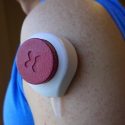UW grant program seeds promising ideas, like safer batteries
Batteries are bundles of energy, and the more, the better. But bad things can happen when something goes wrong with that bundle of energy, as Boeing learned when its 787 Dreamliner planes were grounded due to two backup-battery fires in one week in 2013.
Those fires highlighted something that was on the minds of two chemistry professors at UW–Madison a decade ago. In 2007, Robert Hamers and Bob West created a spinoff company to develop a compound they had invented that placed the high-energy density of batteries based on a lithium ion electrolyte into an inherently safer structure.
That spinoff, called Silatronix, now has 15 employees and is moving its patented electrolyte toward the market. But one problem remains, Hamers says. “We don’t know why it works; the fundamental scientific understanding is lacking.”
In September, the Hamers lab received a $73,800 State Economic Engagement & Development (SEED) grant from the UW to study the stability of its compound at high temperatures, and for theoretical calculations on the link between energy storage and molecular structure.
UW-Madison Ph.D. student Sarah Guillot conducts research on new battery materials in a glove box that prevents exposure to air. The research at Robert Hamers lab received funding from the SEED program’s first round of grants.
Photo: Robert Hamers
“I’m excited,” says Hamers, who is chief technical officer at Silatronix. “We have facilities on campus that are extraordinarily useful for characterizing what happens when the compound begins to break down.
“Silatronix has always wanted to focus on application-driven research. SEED gives our lab a chance to focus on what the university does best, which is the fundamental science, while at the same time producing results that may benefit the company, and also the Wisconsin economy.”
The SEED grants are administered by the Office of Industrial Partnerships to support research that interests a researcher and a spinoff he or she founded. However, they do not directly support the business.
The grants will fund researchers who have disclosed an ownership or management interest in the company on an outside activity report, says Richelle Martin, industrial partnership specialist at SEED, “so we know in advance how to avoid conflicts of interest and already have a management plan in place.”
“The university is under a directive from the state to be more of an economic engine. How do we target our resources to create the maximum, quantifiable economic impact? We do that by targeting startups.”
Bill Barker
“Although we will fund research on campus that will be of interest to the company, there is no agreement with or obligation to the company,” Martin adds. “This funding will further a line of research in an area of mutual interest.”
SEED’s program guidelines require that inventions be disclosed to the Wisconsin Alumni Research Foundation, and upon request, any patents be assigned to it, says Bill Barker, director of the Office of Industrial Partnerships, which is housed in the Office of the Vice Chancellor for Research and Graduate Education.
The SEED program is a follow-up to I&EDR, the Innovation and Economic Development Research program. “The university is under a directive from the state to be more of an economic engine,” Barker says. “How do we target our resources to create the maximum, quantifiable economic impact? We do that by targeting startups.
“We see SEED as helping good small businesses get off the ground, and we have faculty on this campus who say that funding under the predecessor I&EDR was critical to success.”
During fiscal year 2015, its first year, SEED started disbursing $700,000 to five laboratories. The next round of grants is budgeted at $625,000.
Subscribe to Wisconsin Ideas
Want more stories of the Wisconsin Idea in action? Sign-up for our monthly e-newsletter highlighting how Badgers are taking their education and research beyond the boundaries of the classroom to improve lives.



